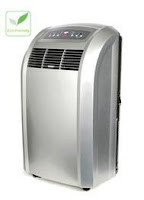As summer approaches, you might be thinking that it's time to get a new
air conditioner. Before you go out air conditioner shopping, however, perhaps
you should get a sense of how much is this is actually going to cost you.
Central air conditioners are the most expensive of all of the available
units, costing many thousands of dollars. But some small portable AC units can
cost you as little as $100.
 |
| Whynter 12000 BTU Portable Air Conditioner |
To get a high-quality portable AC unit from a top manufacturer, you can
expect to spend anywhere from $300-$700. These are the most expensive of the
non-central air-conditioners. You will pay a premium for the convenience of a
portable AC unit.
Bear in mind, however, that Consumer Reports doesn’t actually recommend
any portable AC unit. CR has tested portable air conditioners and its reviewers
argue that portable units don’t cool as well as they claim.
A brand-name window air conditioner, however, is can be priced much more
reasonably, running anywhere from $150-$400 for a low level of BTUs (under 8000
BTUs, for example) while a larger capacity unit can run anywhere from $400-$800.
Finally a through-the-wall model can cost you anywhere from $300-$1500.
 |
| Frigidaire 15100 BTU Window Air Conditioner |
In terms of installation costs, these can vary widely depending on which
type of air conditioner you plan to buy. For example, portable and window AC
units require no special installation. So once you buy the unit, it that is all
that you will spend except for, of course, the monthly electricity bill. A
window unit might require some minor installation, but you can do it yourself
and it won’t cost much at all.
For moderate installation costs, consider a through-the-wall unit. To
install one of these air conditioners, you can expect that the cost will be
under $300. This is pretty low because these units don’t require ductwork.
When shopping for a central AC system, the cost of the unit and
installation increase considerably. If you already have a furnace in place and
the duct work is already done, you can expect that adding a new central air
conditioner to your home will cost about $3500-$4500. Of course, the price will
vary depending on which brand you buy, which model you choose, and how big the
cooling capacity is.
If you have to put in new ductwork as well as install the AC unit, the
price of installing central air can jump up to $8000. If this is the case in
your home, you might consider going with a ductless mini split system, which
does not require ductwork.
If
you're replacing old central air conditioner, bear in mind that there may be
higher costs involved because the installers may need to fix the insulation in
the older ductwork.
This is important because you did not want the cool air to
leak out of the ducts if they are poorly insulated. This can happen if the cool
air is escaping the ducts and not making it to you room. This can cost you a
ton of money and energy bills.



